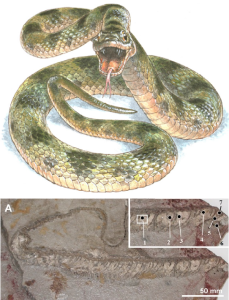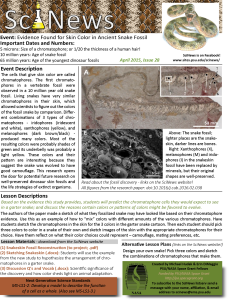When you are at a museum, ever wonder how scientists know the color of an animal that lived a long time ago? Well, scientist are working hard to figure this out so they don’t have to guess! Some animals, including fish and reptiles, have groups of cells called chromatophores that give skin its color. For the first time ever, scientists found chromatophores in the fossil of a snake that lived 10 million years ago. By comparing the shapes of chromatophores found in fossilized snake to those of snakes living today, scientists were able to figure out what colors the ancient snake was! Different combinations of 3 types of chromatophores – iridophores (iridescent and white), xanthophores (yellow), and melanophores (dark brown/black) – produce many colors. The scientists found that the ancient snake had different shades of green on top and its underbelly was probably a light yellow. These colors, and their pattern, are interesting because they suggest the snake had evolved to have good camouflage. This research leads the way for determining skin pigment of other animals such as dinosaurs!
Issue 28 – Evidence for Skin Color Found in Ancient Snake Fossil
Please review this lesson using this quick 5 minute, 10 question survey.
Our funding depends on your feedback!
- Read about the discovery here and for additional information and pictures here. Or check out the original article in this pdf.
- Nation Geographic investigates how natural selection can rapidly change the a color of a population.
- NPR piece on the evolution of the color and the unique properties of the color blue.
SciNews Lesson Materials
- Snakeskin Fossil Reconstruction (.pdf): To project as an example for the activity.
- Sketching Snakeskin (.docx): Students will use the example from the new study to hypothesize the arrangement of chromatophores in a garter snake.
- Background info and discussion Q’s (.docx): Scientific significance of the discovery and how color sheds light on animal adaptation.
- Design your own snakeskin! Think about the adaptive purposes of your color choices and what might cause them to evolve.



Like Us on Facebook!